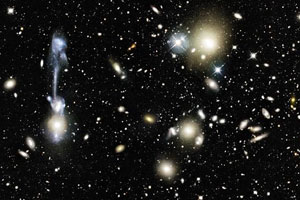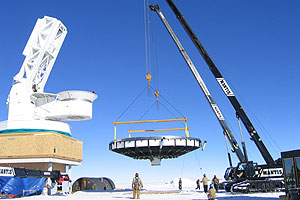 Much like bumper cars, galaxies fly about the center
Much like bumper cars, galaxies fly about the center
and smash into one another. As a demonstration,
the large blue galaxyon the left, nicknamed
the guitar galaxy,is torn apart as it collides
with another member of the cluster.*In the last two posts, I talked about solar systems and galaxies, you know, the really small stuff. Personally, I'm interested in the cosmological behemoths: clusters of galaxies. In fact, I studied these behemoths for five years in graduate school.
As the name would imply, a cluster of galaxies is a large system of galaxies, much like a solar system is a system of planets and a galaxy is a system of stars. In the largest clusters, there are thousands of galaxies, each trapped by the enormous gravity of the entire cluster. The largest cluster members are among the very first galaxies to have formed in the universe. Living in the rich cluster environment, they’ve had a lot of time to grow through collisions with other cluster galaxies, and are also among the largest galaxies in the universe.
There are probably around 1,000 known galaxy clusters. All of the known clusters have been discovered using well-established techniques, such as just taking pictures through a telescope. However, we’ve only managed to search a small bit of the universe, and we believe there are hundreds of thousands still out there, waiting to be discovered.
For three summers, I searched for new clusters using two California telescopes: the BIMA array in Hat Creek and the OVRO array near Bishop. With all those massive clusters, you'd think it would be a breeze to find them. For better or for worse, I was using a fairly new technique which hadn't really been developed to the point of routine use and I came up empty-handed.
This new technique targets a unique signature of galaxy clusters, the Sunyaev-Zel'dovich effect, or as it is more affectionately known, the SZ effect. The SZ effect describes how a galaxy cluster appears silhouetted against the glow of the big bang known as the cosmic microwave background, or CMB. I'll cover this in a later post, but if you are anxious for more details, feel free to ask.

 Construction at the South Pole
Construction at the South Pole Panoramic view of the South Pole Telescope
Panoramic view of the South Pole Telescope